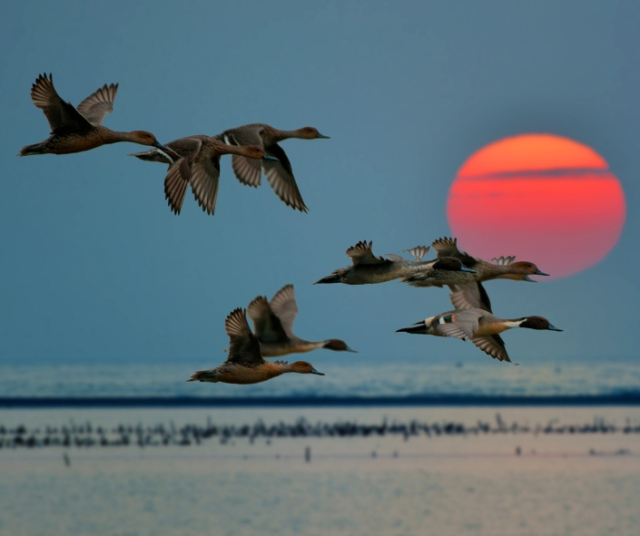World Migratory Bird Day , an initiative sponsored by the United Nations Environment Program ( UNEP ), is an annual celebration that highlights the importance and beauty of migratory birds in our global ecosystem. This event, which takes place each year on the second weekend in May, serves as a reminder of the extraordinary odyssey that millions of birds undertake each year, traveling thousands of kilometers on their migratory journeys.
History of World Migratory Bird Day
World Migratory Bird Day was established in 2006 by the Agreement on the Conservation of African-Eurasian Migratory Waterbirds (AEWA) and the Convention on the Conservation of Migratory Species of Wild Animals (CMS). The main objective of this day is to raise awareness among the world's population about the need to conserve and protect migratory birds and their habitats.
Each year, World Migratory Bird Day focuses on a specific topic related to the conservation of these birds. Previous topics include plastic pollution, illegal hunting, climate change and habitat loss. These themes highlight the critical challenges migratory birds face as they struggle to survive and thrive in an ever-changing world.
The Amazing Odyssey of Migratory Birds
Migratory birds are true athletes of the animal kingdom. Every year, millions of these birds undertake epic journeys, traveling distances that defy human imagination. From the polar regions to the tropics, these birds follow migratory routes established over thousands of years of evolution.
One of the most famous migratory routes is that of birds that travel between the Arctic and Antarctica. These birds, like albatrosses and petrels, travel amazing distances, following the winds and ocean currents in their search for food and breeding sites. Their journeys can span tens of thousands of kilometers and are a testament to the incredible resilience and adaptability of these creatures.
Another notable example of migration is the annual flight of birds of prey across North America. Eagles, falcons and other birds of prey congregate in large numbers in strategic locations to take advantage of thermal currents and make a journey that can span thousands of kilometers. This natural spectacle is not only impressive, but also highlights the importance of conserving the habitats of these birds throughout their migratory range.
Challenges Along the Way: Threats to Migratory Birds
Despite their amazing ability to travel enormous distances, migratory birds face a number of challenges that threaten their survival. Climate change, habitat loss, pollution and illegal hunting are just some of the problems that affect these birds during their migratory journeys.
Climate change, in particular, has a significant impact on the migratory routes and weather patterns that birds use to navigate. Alterations in temperature, wind patterns and seasons can affect food availability and breeding sites, endangering the survival of migratory bird populations.
Habitat loss is another critical threat. Urban sprawl, deforestation and other landscape changes can destroy key feeding and breeding grounds for these birds. The conservation of natural areas and the creation of ecological corridors are essential to ensure that migratory birds have access to the habitats they need to survive.
Pollution, in its various forms, also affects migratory birds. Water and air pollution can directly harm birds or affect food availability. The proliferation of plastics in the oceans, in particular, has emerged as a critical problem affecting many species of migratory seabirds.
Illegal hunting, although often regulated by international treaties, remains a threat to some migratory bird populations. Indiscriminate hunting can decimate populations and endanger the long-term viability of these species.
Conservation and Protection: The Role of World Migratory Bird Day
World Migratory Bird Day is not only an opportunity to celebrate the amazing diversity of birds that populate our planet, but also to highlight the importance of conservation and protection of these species. Public awareness is essential to encourage strong and sustainable action to address the threats faced by migratory birds.
Conservation initiatives must address a variety of problems. At the international level, cooperation between countries is essential to ensure the protection of migratory routes and the sustainable management of critical habitats. International treaties and agreements, such as CMS and AEWA, play a crucial role in providing a framework for global collaboration in the conservation of migratory birds.
At the national level, the creation and maintenance of protected areas is essential. These spaces provide shelter and suitable habitats for migratory birds, allowing them to reproduce and rest during their journeys. Environmental education and community participation are also powerful tools to involve the population in the conservation of migratory birds and their habitats.
Scientific research plays a crucial role in understanding the needs and behaviors of migratory birds. Monitoring populations, studying migratory routes and evaluating environmental impacts are key components to developing effective conservation strategies.
Celebrating the Success of Migratory Bird Conservation
Despite the challenges, there are success stories in migratory bird conservation. Some species, thanks to concerted conservation efforts, have seen increases in their populations. These successes demonstrate that human action can have a positive impact and offer hope for the future of these species.
A notable example is the case of the bald eagle in North America. This majestic bird of prey, a national symbol of the United States, was on the brink of extinction in the 1960s due to hunting, pollution and habitat loss. However, thanks to the banning of pesticides such as DDT, the creation of protected areas, and conservation efforts, bald eagle populations have recovered impressively.
Another inspiring example is the red-crowned crane in Asia. This species, which breeds in Russia and migrates to China and Japan, has experienced an increase in its populations thanks to the protection of its habitats and international collaboration in conservation.
In conclusion, World Migratory Bird Day is more than an annual celebration; It is a reminder of the wonder of nature and a call to action. By uniting in our commitment to conserve and protect migratory birds, we are working toward a future where these incredible creatures can continue to delight us with their majestic flights across open skies and pristine habitats.
